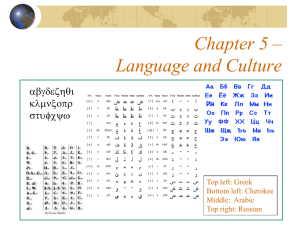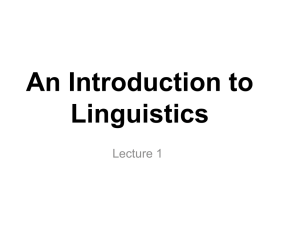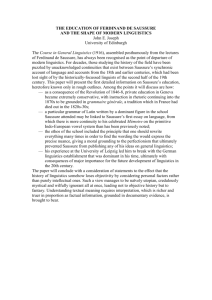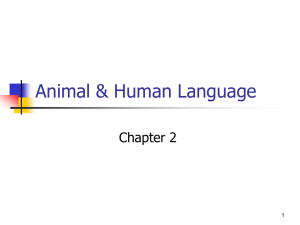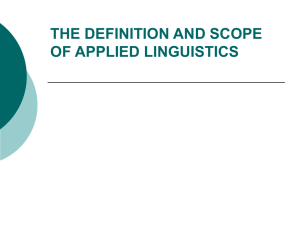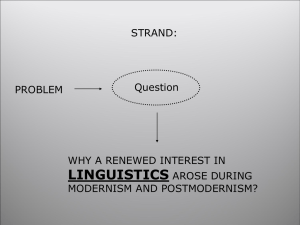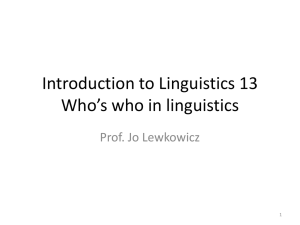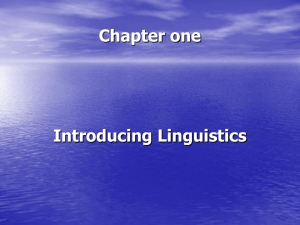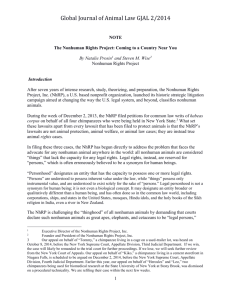Introduction to Linguistics - WordPress.com
advertisement
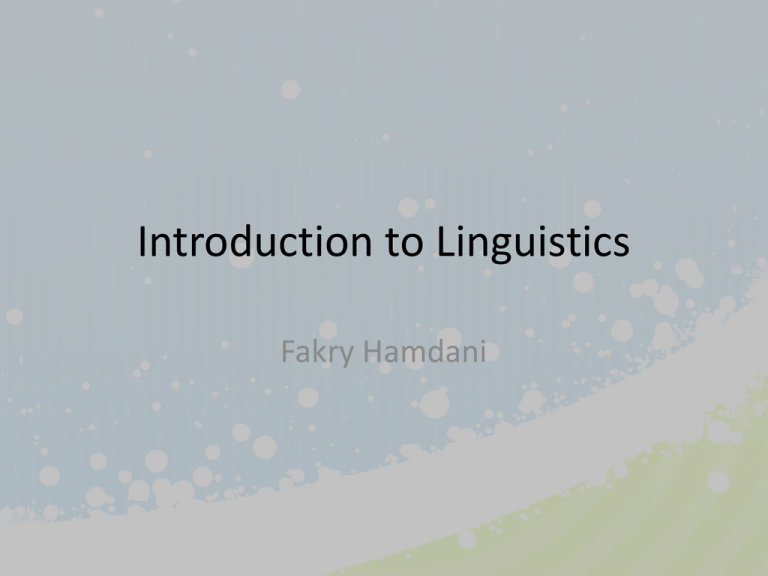
Introduction to Linguistics Fakry Hamdani LINGUISTICS • Linguistics (n.) The scientific study of language; also called linguistic science. (David Crystal:2008) • Linguistics is a comparatively new science, or new, at least, in the form it has taken in recent years. The science seeks to answer the following questions: (a) what exactly do we know when we know a language (b) how is this knowledge acquired and (c) how is such knowledge used? (Petra) Langage, Langue & Parole • langage /lFìapè/ (n.) A French term introduced by Ferdinand de Saussure to refer to the human biological faculty of speech. (David Crystal:2008) • It is distinguished in his approach from langue, the language system of a speech community. • langue denotes a system of internalised, shared rules governing a national language’s vocabulary, grammar, and sound system; • Parole designates actual oral and written communication by a member or members of a particular speech community. Contexts in which linguistics arose • philosophy (Greece) • language teaching (Alexandria) • philology (study of ancient texts, often of sacred nature) (India, Greece) Cratylus: a Socratic dialogue Protagonists: • Cratylus: words are natural signs, some names are ‘correct’ others are not • Hermogenes: names are arbitrary/ conventional • Socrates: middle position: there is such a thing as a correct name, but names may be corrupted, and yet be used Etymology of theos ‘god’ Socrates: It seems to me that the first inhabitants of Greece believed only in those gods in which many foreigners still believe today – the sun, the moon, earth, stars and sky. And, seeing that these were always moving or running, they gave them the name ‘theoi’ because it was their nature to run (thein). Modern View (F. de Saussure) • words and expressions are basically conventional: arbitrary by agreement in a speech community • no Humpty-Dumpty • partial motivation of signs possible: 1. when they are complex 2. onomatopoetic words 3. (maybe) sound symbolism Study of human language The interdisciplinary nature of modern Linguistics Determining Sincerity • In an essay that looks at media coverage in the aftermath of the death of Princess Diana on 31 August 1997, Martin Montgomery discusses ways in which audiences constructed their own ideas about the sincerity of what they saw and heard on radio and television. • The essay examines ways in which members of the British public reacted to the three highest-profile tributes broadcast by the BBC in the days following Diana’s death. • The first of these was a television interview given by Tony Blair. Standing in the open air, Blair spoke without notes direct to camera, his voice trembling and hesitant with emotion. • On 5 September came the second major broadcast, a speech to the nation by the Queen. She expressed her sadness at the death of her daughter-in-law and declared that she was speaking as ‘your Queen and as a grandmother’. • This broadcast was made live, using a teleprompter and showed the Queen composed and speaking clearly and fluently. • The third speech analyzed was the address by Diana’s brother, the Earl Spencer, at her funeral service in Westminster Abbey, when he pledged that her ‘blood family’ would do all they could to raise her sons as she would have wished and appeared to be on the verge of breaking down in tears towards the end of his oration. What is language? • A system of symbols with standard meanings. • Allows humans to communicate and is the main vehicle of transmission of culture. • Language provides context for symbolic understanding. Other Communication • Human: – Direct • Body language (kinesics), tone of voice, personal space (proxemics), gesture – Indirect • Writing, mathematics, music, painting, signs • Nonhuman: – Sounds, odors, body movements – Call systems, ethologists – ASL – American Sign Language Nonhuman Communication - ASL • American Sign Language taught to chimps and gorillas – Physiologically and developmentally similar to humans. – Chimps taught: Lana, Nim, Kanzi, Washoe – Gorillas taught: Koko Nonhuman Communication - Washoe • Born 1965 • Taught ASL 1966 • Mastered 100s of signs • First nonhuman to learn language Nonhuman Communication - Lana • Taught with keyboard, 1970s • Able to use and combine signs Nonhuman Communication - Koko • 1970s, first gorilla taught ASL • IQ of 85 at 4 years old • Koko learning ASL • Koko on AOL Nonhuman Communication – Nim Chimpsky • 1980s taught ASL • Wouldn’t initiate conversation • Never signed to other chimps Nim Chimpsky and his namesake, the famed linguist Noam Chomsky Nonhuman Communication - Kanzi • 1980s, communicates with lexigrams • Vocabulary of 90 symbols • Could understand English • Command of syntax Nonhuman Communication – Jane Goodall • Gombe Game Reserve • Chimps need stimulus to make sounds • Since 1960s Animal v. Human Communication • Four differences: – – – – Productivity (infinite expressions) Displacement (past, present, future) Arbitrariness (no link between word and sound) Combining sounds (phonemes) • Dime versus dine or lock versus rock in English • English has 45 phonemes; Italian 27; Hawaiian 13 • Nonhuman animals cannot combine sounds (1:1 correspondence of sounds) Anatomy of Language • Brain – – – – – Size Laterality Wernicke’s area Broca’s area Motor cortex Motor cortex Anatomy of Language • Respiratory System – – – – Larger lung capacity Larynx, pharynx Tongue, lips, nose Hyoid Structure of Language • • • • • Phonology (sounds) Morphology (words) Syntax (sentence structure) Semantics (meaning) Pragmatics or grammar (rules) Structure of Language - Phonology • The study of sounds of a language. • No human language uses all the sounds humans can make. • IPA – International Phonetic Alphabet • Phonemes and phones – /l/ and /r/ = phonemes (English has 40) – /p/ and /ph/ = phones – Ghoti = fish (tough, women, position) • Other sounds – Tones, nasals, clicks (Genesis in the !Kung language) Structure of Language - Morphology • Morphemes are the smallest units of language. – Words (dog, cat) = free morphemes – Prefixes (un-, sub-) – Syllables (-s, -ly ) • Declining and conjugating = bound morphemes – Verbs are conjugated (am, are, is) – Nouns are declined in some languages • Latin, Greek, German, Russian, etc. • Word form changes based on position in sentence. Structure of Language - Syntax • Rules for how to put together sentences and phrases. • Six possible arrangements, based on Subject, Verb, Object – English is SVO = The girl will hit the boy. – Forming questions: English = V1SV2O? Structure of Language - Syntax • Example of syntax • Lewis Carroll’s Jabberwocky: ‘Twas brillig, and the slithy toves Did gyre and gimble in the wabe. All mimsy were the borogoves, And the mome raths outgrabe. Verb Noun Adjective Structure of Language - Semantics • The meaning of symbols, words, phrases, and sentences of a language. • Ethnosemantics and kinship terms – Aunt/uncle versus non-gendered cousin Evolution of Language • Old Theories: – “bowwow” and “ding-dong” – Locke, B.F. Skinner, Descartes • New Theories: – Noam Chomsky • Universal and generative grammar • Principles and parameters – Creoles, pidgins, and Ebonics – Sapir-Whorf Historical Linguistics • Focuses on how language changes over time and how languages relate to one another. • Anthropologists are interested in cultural features that correlate with language families. • Reconstruction of languages: – Proto-Indo-European – Sino-Tibetan • Linguistic divergence – Gradual or by force PIE Historical Linguistics – Old English • Compare Old, Middle, and Modern English • Beowulf (Old English): Hwæt! We Gardena in geardagum, þeodcyninga, þrym gefrunon, hu ða æþelingas ellen fremedon. Oft Scyld Scefing sceaþena þreatum, monegum mægþum, meodosetla ofteah, egsode eorlas. Lo, praise of the prowess of peoplekings of spear-armed Danes, in days long sped, we have heard, and what honor the athelings won! Oft Scyld the Scefing tore the mead-bench from squadroned foes, from many a tribe awing the earls. Historical Linguistics – Middle English • The Canterbury Tales (Middle English): This worthy lymytour, this noble Frere, He made alwey a maner louryng chiere Upon the Somonour, but for honestee No vileyns word as yet to hym spak he. This worthy limiter, this noble friar, He turned always a lowering face, and dire, Upon the summoner, but for courtesy No rude and insolent word as yet spoke he. Descriptive Linguistics • Also called structural linguistics • Tries to discover the rules of phonology, morphology, and syntax of another language, especially those with no written dictionary or grammar. • Seeks to discover language rules that are not written down but are discoverable in actual speech. Sociolinguistics • Like descriptive linguistics in a way, in that sociolinguists are concerned with the ethnography of speaking—cultural and subcultural patterns of speech variation in different social contexts. • Examples: – – – – Pronunciation and dialects Honorifics and social status Gender differences Multilingualism Fun Stuff • Language as art – Calligraphy – Illumination Left to Right: Chinese Greek Arabic English Semiotics: Some Points of Reference Semiotics • ‘Science of signs’ • Signification: systematic, structural aspects of signs; meaning-bearing potential • Communication: transactional aspects of signs; cf. Jakobson’s codes and messages, source and destination, channel and context The Sign [N] • Saussure: signifier-signified; arbitrary and conventional signs; (mentalistic) • Peirce: – Representatum (perceptible object) – ‘stands to somebody, for something – Object in some respect’ – To create an interpretant [itself a sign]’ – Categories of Firstness, Secondness and Thirdness Saussure’s Theory of the Sign • Sign = Linguistic form + Meaning • ‘The word cat’ = [kh æ t] + Signification • ‘The word cat’ = [kh æ t] + • SIGN = SIGNIFIER + SIGNIFIED Signs are Arbitrary • • • • Water Wasser Eau Shui /li:/ •“lit” in French = bed •Question marker in Russian •“meadow,” “side sheltered from the wind,” or “proper name Lee” in English Onomatopoeia • • • • – [kakodudldu] – [kikiRiki] German – [kokoRiko] French – [kukuku] Spanish – [miauw] – [miauw] German – [meauw] Chinese – [niauw] Japanese Linguistic Relativity • English has 11 basic color terms. • Russian has 12 – siniy (dark blue),goluboy (light blue). • Shona (a language of Zimbabwe) has 3: citema (black), cicena (white),cipswuka (red). • Bassa (a language of Liberia) has 2: hui and ziza. Semioticians • Saussure Hjelmslev Greimas, Metz and Eco – structuralism; content-expression (signified-signifier); linguistic bias; paradigms and syntagms • Peirce Morris – rich typologies of signs; emphasis on process of semiosis (syntactic, semantic, pragmatic dimensions); semiotic typology of discourse • Eco – ‘toward a logic of culture’; a theory of codes and a theory of sign production • Sebeok – ‘how the body interacts with the mind to produce signs, messages, thought and ultimately cultural behaviour’ Summary: Five Notions of Semiotics [ENC] • The syntactic, semantic and pragmatic properties of the sign • A theory or discipline studying these properties • Theories about how to study these properties • Methods: “method of formalization; method of language analysis; method of interpretation” • Application: “use semiotics to analyze some fragment of reality, e.g. arts, architecture, film… fashion, folk customs, etc.” ‘Summary’ [ENC] • “Semiotics, depending on whether it is defined as a type of research or as a doctrine, as a theory or as a set of methods, can use the tools of several sciences or doctrines, from logic and metamathematics to linguistics, aesthetics, and all the ‘social sciences.’” • But, “it must refer constantly and consistently to any of its possible objects through sign and sign functioning, using methods implying a theory of signs and sign function”
